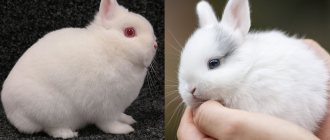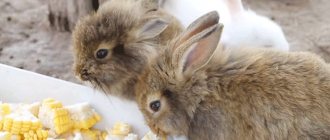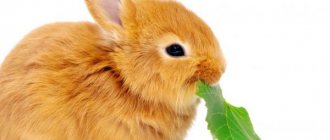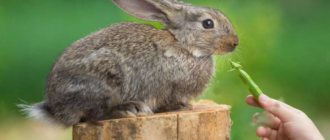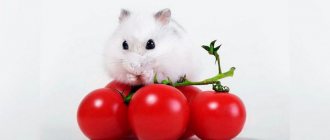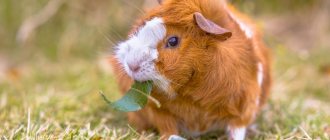Livestock » Rabbits
2
6511
Article rating
Kira Stoletova
To raise healthy and strong animals, you need to know the features of their diet. How many times a day should rabbits be fed? Let's look at what and in what quantity should be given to long-eared animals so that problems do not arise in the future.
Rules for feeding rabbits
Nutrition Basics
It is difficult for novice livestock breeders to understand the intricacies of breeding, so they often make certain mistakes. No need to calculate the ratio of proteins and carbohydrates per month on a calculator. Knowing the basics of feeding can help you avoid trouble.
- Quality products. It is forbidden to feed rotten or moldy food. Soaked, frozen or frost-covered food is a source of disease.
- Varied menu. Even the most delicious diet quickly becomes boring. Rabbits are more sensitive to food, so it is important to offer them a variety of foods.
- Water. Dry food is better digested only with an abundance of fresh liquid. The lack of an important element is first reflected in the form of constipation and lack of milk in lactating females.
- Food is given at a certain time. Animals quickly get used to the schedule and wait for food.
- You cannot feed all groups the same. The daily intake for each type of rabbit is different.
Long-eared animals eat at least 30 times within 24 hours. According to the Mikhailov system, animals have regular access to products. In nature, a rodent constantly finds twigs or grass, so the body receives nutrients in sufficient quantities. In this case, the livestock grows healthy and strong, without a single hint of obesity.
When kept in cells, they necessarily receive not only plant food, but also animal products. Experienced breeders provide fish oil, bone meal and whole milk with whey. It is useful to give silage with the addition of beets, potatoes and concentrate. Be sure to include microelements.
What is feed and how much does a rabbit need?
If it is not possible to give the animal natural food, you can give preference to the most ordinary compound feed. This food contains a balanced amount of vitamins and minerals. It also contains carbohydrates, proteins and fats in the required quantities. In addition, it also contains protein necessary for the rabbit’s body. This type is absorbed by the body for quite a long time, so it should be introduced gradually and over a huge period of time. The most nutritious and useful elements of feed are:
For feeding, these products are very suitable for the animal and give it an incredible amount of energy and strength. Naturally, the best feeding option both in winter and summer is compound feed, although it is quite expensive. It is worth highlighting the following types:
The complete version of compound feed contains the necessary vitamins and other useful substances in normal proportions, which will be sufficient for the normal functioning of such an animal. Among feed additives, a variety of minerals and vitamins should be highlighted. When introducing such elements into feeding, you should know some of the characteristics of the animal’s body. If there is no normal amount of vitamin A, the rabbit may develop problems with vision and the reproductive system. Vitamin B will help for the functioning of the digestive system. But to maintain immunity at a good level, a decorative rabbit urgently needs vitamin C.
If we consider the so-called concentrate feed, it is a mixture of cereals and legumes. In fact, this is the feeding option that every animal should have. Often it contains almost identical elements, among which you can find bran, yeast, pieces of meat, grains and various vitamins and minerals.
Feeding mode
Rabbits eat very often, so it seems to beginners that the animal is constantly chewing on something. Farmers prefer two meals a day: morning and evening. At home, they practice feeding food three times a day:
- in winter - at 8, 12 and 17 o'clock;
- in summer - at 6, 15 and 19.
Rabbit diet
In cold weather, in the morning and evening, give half the ration of concentrate (grain) and the same amount of silage. At noon it is better to feed with root vegetables. In warm seasons, at the beginning and end of the day, preference is given to dry food (50%) and grass. Dried greens are divided into 3 portions and added each time.
This diet will help to quickly build muscle mass in animals. Always check the availability of drinking water. In cold weather, the liquid must be warmed to room temperature.
Energy requirement
The energy requirement of rabbits, per unit of live weight, in comparison with other domestic animals, is significantly higher. When rationing the feeding of rabbits using a factorial method, energy costs for maintaining life and energy costs associated with various physiological states (lactation, pregnancy, growth, development, etc.) are distinguished. For example, during the mating period, the diet of males in terms of energy indicators must be increased, in comparison with the supporting feeding background, by 40%. The diets of females at the beginning of pregnancy according to this indicator are increased by 30%, and in the second half they are increased to two norms of maintenance energy. During lactation, the need for energy increases sharply. During 2, 3-4, 5-6, 7-8 weeks of lactation, the rabbits’ energy requirement is respectively 200, 300, 400 and 600% of the maintenance level of the diet.
According to foreign experts, the norm of maintenance energy for adult rabbits with a live weight of 3 kg is 280 kcal (1.15 MJ), 3.5 kg - 320 kcal (1.32 MJ), 4 kg - 350 kcal (1.44 MJ), 4.5 kg – 380 kcal (1.56 MJ). At the same time, 100 g of feed for adult rabbits should contain at least 250 kcal (1.05 MJ), but not more than 270 kcal (1.13 MJ) of metabolic energy, and for young animals - accordingly, at least 280 kcal (1.17 MJ) ), but not more than 320 kcal (1.34 MJ).
Fattening
Meat breeds are raised according to a certain pattern. It is important to not only gain weight in a few weeks, but also get an excellent ratio of meat and fatness. Experienced livestock breeders recommend starting the process 42 days before the expected slaughter.
What and how many times a day should you feed rabbits? More than 50% of the menu consists of concentrates, and to increase fat it is recommended to feed boiled potatoes, corn and barley. Sometimes peas and oats are allowed, and parsley and dill are mixed with hay.
Animals should move less and gain weight faster. To do this, their movement is limited to a cage in which no more than 6 eared heads sit. They are sent to slaughter after the individuals become lazy and have little interest in food.
Reviews
Nikolay, 37 years old
We have a large farm, so we specially go to the feed mill to buy feed. To save money, we buy concentrates, which we add to the main diet. We directly pour the granules into the feeders, and we dilute the loose feed and give it out in mash. After switching to specialized feed, our weight gain increased and the quality of the skins improved.
Elena, 29 years old
I have a small decorative rabbit, it eats very little, I buy a full ration of food for it at the pet store. Very convenient: the bag for the animal contains a specially selected composition of vitamins, fiber, proteins, protein, and microelements. There is no need to think about what to feed your pet - just pour granules into a cup, and all problems are solved. After eating, the rabbit is always cheerful and energetic, the fur is smooth and shiny.
In modern rabbit farming, the use of compound feed is a prerequisite for obtaining stable weight gain, high-quality wool and healthy offspring.
Diet during mating
To get healthy and strong rabbits, you need to take care of the condition of the future parents. Thin people are provided with enhanced nutrition, and fat people are put on a diet. Too little or too much fat leads to stillbirth and reduces sperm quality in males.
Enhanced feeding of exhausted individuals begins a month before the mating period. It is necessary to increase the daily diet, bringing it closer in nutritional value to the menu of pregnant women. Abundance and variety are complemented by multivitamins.
To improve sperm quality in males, you need to use protein foods. To enrich food, oilseed cake, meat and bone meal and fish meal are added. During the mating period, you should not use products that contribute to obesity, therefore exclude:
- barley;
- corn;
- potato.
The viability of the rabbits depends on the health of the producing animals. It is advised to provide a nutritious and varied diet with a sufficient amount of useful microelements. Veterinary supplements can be used at this stage.
What should a rabbit eat during the rest period? A typical diet consists of one-third grain and 70% hay. Added to food (in grams per head):
- salt - 1;
- bone meal - 4;
- ground shells - 2.
How to prepare meat puree for first feeding
Meat puree recipe for complementary feeding
Making meat puree at home is not so difficult; to do this, you need to take 20-30 grams of lean meat, without fat and films, wash it, chop it finely or grind it in a meat grinder.
Cook for 30-40 minutes, then separate from the broth, add a little breast milk or formula, beat with a blender, or grind several times in a meat grinder and rub through a sieve.
Meat puree for baby's nutrition is ready; no need to salt it. Milk can be replaced with vegetable broth.
In this form, children receive their first meat food, in the form of puree, to which they are already accustomed when they became acquainted with vegetables and fruits.
At a later age, it will be possible to add salt to meat dishes, add herbs, bay leaves, a little butter or cream at the end of cooking, and also prepare meatballs, soufflés and steamed cutlets when the baby can chew on his own.
After a year, the baby can switch from homogenized puree to medium-ground dishes. The soups are prepared in vegetable broth, the meat is cooked separately and chopped, then combined with the broth, and the vegetables can be mashed with a fork.
Features of the female menu
A pregnant rabbit eats a lot. Obese mothers find it difficult to give birth. Before giving birth, the daily allowance is reduced, but starvation is not allowed. Lack of nutrients leads to a delay in the natural development of the fetus.
One female rabbit eats from 60 to 100 g of plant food (oats, concentrate, legumes) per day. Additionally, add sunflower or soybean cake - no more than a third of the norm. Since there is no lactation yet, half a kilogram of grass is enough.
Don’t forget about carrots and potatoes: 250 g per head. Pregnant females must be given minerals and vitamins, and fish oil and meat and bone meal are suitable as natural supplements. It is important to monitor water quality.
After childbirth, you need to increase lactation. A nursing rabbit eats green grass in the summer, and in cold seasons it is better to feed root crops, hay and silage. Feeding rates increase in the period from 20 to 45 days (in grams per individual):
- mixed feed - 150;
- juicy menu - 300;
- grass - 1000.
Lactating females need to consume 60-70 g of protein per day in food. Their food should contain at least 17-18% of the important product.
The babies watch their mother and soon begin to try adult food themselves. To prevent the rabbit from starving, you need to add 30 g of concentrate and hay to the daily dose in winter, and 25 and 60 g in summer. In this case, you don’t have to worry about a lack of food and a decrease in lactation.
Junk food
Rabbits are herbivores, and therefore green food forms the basis of their diet. However, there are herbs that rabbits should not eat, because... they pose a serious threat to the health and life of animals. The most dangerous: hemlock, hemlock, dog parsley, foxglove, wild radish, celandine, larkspur - all of them are extremely toxic. Hemlock and dog parsley have a detrimental effect on the rabbit's nervous system. Veh and foxglove cause severe disorders of the cardiovascular system. Intoxication with wild radish and celandine is expressed by intestinal bloating, colic, diarrhea, often ending in death (especially from celandine). And larkspur seems to have brought together all those types of negative effects that distinguish the herbs listed above. Larkspur causes disturbances in the functioning of the cardiovascular, respiratory, nervous and gastrointestinal systems (colic, diarrhea, vomiting). No less dangerous are hellebore, spurge, aconite (fighters), lily of the valley, belladonna, dope: they act in the same way as the herbs described earlier.
Qualified assistance from a veterinarian, called at the first sign of poor health in rabbits, will help cope with poisoning of animals with toxic herbs. And it’s better, of course, to try to avoid such incidents...
Features of the young cattle menu
Feeding rabbits has its own subtleties. It is better to place babies in the period from 30 to 45 days after birth. If you are deprived of mother's milk at an earlier age, the digestive system of young people will not have time to form correctly. Any “adult” diet is not suitable for eating crumbs, so everything new is introduced gradually.
Fattening young rabbits
Experienced farmers prefer to use granular concentrate. The daily feed intake for young rabbits is (in grams per head):
- up to 2 months - from 85 to 125;
- up to 90 days - from 130 to 170;
- from week 13 - from 180 to 200.
By the way, the menu can be varied with greens and hay. Feed is reduced to 85%, and the remaining 15% is used for grass. In the morning, give half the daily allowance of dry food, and in the evening add root vegetables to the rest. During the day, it is recommended not to forget about silage. Wet foods are given in such a way that they are eaten within 1.5 hours.
Carbohydrate needs
Carbohydrates are divided into two groups: fiber and nitrogen-free extractives (NFEs). In this case, fiber includes cellulose, hemicellulose and lignin, and non-fuel materials include sugar, starch, part of hemicelluloses, organic acids, etc. These easily digestible carbohydrates (especially sugar and starch) are sources of energy and play an important role in regulating metabolism in rabbits. When they are deficient in rabbits’ diets, protein-fat metabolism is disrupted, and acidosis occurs due to an increase in the level of ketone bodies in the blood and a decrease in its reserve alkalinity.
Fiber is the main source of indigestible organic matter. Both low and high levels of its content in the dry matter of rabbit feeds negatively affect the nutritional value of diets. At a low content (20%), the level of digestibility of the main nutrients of feed is sharply reduced. Experts believe that the optimal level of fiber in the diets of females is 12-15% of the dry matter of feed, and in the diets of young animals for fattening - 8-10%.
Summer feeding
Warm seasons are a great time to diversify your animal menu. The basis of the diet is both grass and radish and carrot leaves. Eared beetles are good at absorbing branches of fruit tree varieties. It is not prohibited to offer apples, cabbage and waste from them.
Sugar and red beets should not be given in large quantities. Products cause increased gas formation, which leads to bloating. It is allowed to use fodder types of root crops. To improve digestion, give fragrant herbs:
- sagebrush;
- dill;
- yarrow;
- chicory.
Dried garlic stalks are used to prevent dental problems, and plantain is a natural antibiotic. Young nettle will become a natural source of vitamins. By the way, such a delicacy can be given to both a nursing rabbit and meat rabbits.
How much greenery is allowed per pet? On average, adults eat up to 600 g of grass, rabbits - from 150 g and more. Keeping lactating mothers allows you to increase the norm by 2 times. Using this type of diet reduces the consumption of dry food and saves concentrates.
Feeding with meat broth
In the days of our grandmothers and mothers, it was believed that meat broth was very useful for a child; it was given to children starting from six months and only then was the baby introduced to meat. It was believed that meat broth was very beneficial for the child’s body, easy to digest and assimilate.
Currently, doctors do not advise introducing meat broth into a child’s menu too early. Up to 8 months, the digestive tract does not work at full capacity, the walls of the stomach and intestines are very permeable, and the liver is not yet active enough to neutralize all the extractive substances that have entered the bloodstream from the broth.
It is necessary for the baby to first get used to meat. It is not recommended to give meat broth to children under one year old; it is better to postpone introduction to this dish until 1.5-2 years, but in the meantime you can prepare soup in vegetable broth with the addition of meat, cooked separately.
Possible harm
- Harmful substances boiled from meat remain in the broth, these are: cholesterol, taurine, creatinine, lactic acid, glucose, urea. All these substances have high chemical and biological activity and add flavor to the broth.
- If the meat has been treated with antibiotics or hormones, all harmful substances go into the broth during cooking.
- Consumption of meat broths at such an early age can result in excess uric acid; its crystals deposit in the kidneys and joints, and uric acid also increases allergic reactions.
- Broths stimulate blood flow to the mucous membranes of the gastrointestinal tract, they become irritated, which causes the production of gastric juice. This process is called hyperemia. Hyperemia makes the mucous membranes of the digestive tract vulnerable to allergens.
Benefit
- Due to the high content of extractive compounds, the broth is very tasty, which contributes to a good appetite.
- All beneficial compounds contained in meat end up in the broth when cooked.
- Broths promote increased secretion of gastric juice, thanks to which food is digested faster.
- Substances contained in broths are beneficial for the development of the nervous system.
Winter feeding
During cold seasons, animals often experience vitamin deficiencies. Microelements A, D, E and B12 must be added to the daily food intake for rabbits. High-quality hay and fermented green food will provide the body with important components. Fish oil is added once a day (in grams per head):
- rabbits - 0.5;
- lactating females - 3;
- pregnant women - 2;
- for other animals - 1.
Sprouted grains are rich in vitamin E, so they are regularly given to both children and adults. If you don’t have time to grow greens, then sometimes you can replace them with yeast. For 5 days, one individual is fed up to 6 g of baking product. Then they take a break for 72 hours and repeat again.
What to feed rabbits in winter
Turnips, cabbage and dry grass are fermented in barrels for the winter. Add carrots and salt (1% of the total mass). An adult animal should have no more than 300 g of such food, while 100 g per head is enough for young animals. To prevent vitamin deficiency, experienced farmers sometimes give needles of coniferous crops.
How much should a rabbit eat in winter? During this period, 50% of the total diet consists of concentrates, and the rest is silage and succulent foods. Carbohydrates that can be obtained from boiled root vegetables are perfectly absorbed.
How much feed does a rabbit usually eat per day?
Nowadays, one of the most popular pets, the breeding of which has recently been quite actively carried out, is the rabbit. In order for a rabbit to grow up healthy, it is necessary to take good care of it, including monitoring its daily nutrition. Anyone who is faced with raising this pet for the first time often wonders how much feed a rabbit eats per day. Let's consider how to feed this animal correctly and what the daily amount of food it should consume should be.
How much feed does a rabbit eat per day?
Things to remember
Long-eared pets love to chew on something, so you need to be careful about food of animal origin. Dairy products are included in the menu in limited quantities. For one individual, 10 g per day is allowed, which is used both raw and added to mash.
The rabbit must eat grain, but experienced farmers advise pre-grinding large grains in a crusher. Such food is easily digestible and does not cause rejection in young animals. During feeding, you need to carefully monitor your pet’s taste preferences and not let unloved ingredients be scattered.
Eared animals should not eat fresh bread. It is better to cut the product into small pieces and dry it in the oven. Crackers are used as an additional treat. Do not get carried away with table waste and give food with an abundance of spices and salt.
Autumn and spring are a period of transition from one type of food to another. It is not recommended to carry out the procedure abruptly, otherwise it can cause digestive problems. Gradual introduction of new types of food should be done over 7 days. If diarrhea begins, then the animals should be given oak branches.
Knowing the daily feeding rates for rabbits per head, you can accurately calculate the consumption of a particular product per month. Our recommendations will help you find the optimal menu for each stage of animal life. Thanks to knowledge of seasonal characteristics, it is easy to adjust your diet.
Tips and tricks
Some rabbit breeders claim that rabbits should have plenty of food for up to six months. However, the nutrition of ornamental breeds will be somewhat different from animals in natural conditions. Pets are virtually stress-free and activity-free. This means that their metabolic processes are much slower. Therefore, food in unlimited quantities is the main cause of obesity.
To organize proper nutrition for domestic rabbits, it is recommended to adhere to a number of rules:
Proper and balanced feeding is the key to the health of pets. Errors in diet planning have a negative impact on the functioning of the body. Rabbits themselves are susceptible to obesity, indigestion and other gastrointestinal problems. Dietary recommendations are aimed at preventing them.
Main reasons
To understand the inappropriate behavior of the rabbit, it is necessary to consider the possible reasons for this behavior of the animals. This will help not only quickly solve the problem, but also prevent this situation from recurring. Some of these reasons are given below:
- problem with nest preparation;
- lack of milk in a nursing female or mastitis;
- young age of mother;
- cold in the cage (less than 5 degrees Celsius);
- the birth of non-viable rabbits;
- sexual hunting;
- stressful situations in the external environment;
- nervous character of the female;
- the abandoned rabbits are too weak or dead.
It is necessary to consider the main factors that negatively affect the behavior of the rabbit.
Aggression occurs for various reasons - due to hunger, anxiety, illness
- Improper preparation of the nest for birth. The owners can provoke the female to scatter the cubs if they change the cage 2-3 weeks before giving birth. And during this time period nothing can be changed. As an exception, about five days in advance the female rabbit must be provided with a maternity house - a special box for her privacy, with hay laid out around her, from which the expectant mother will build a nest for the little rabbits. There are known cases when, due to a small amount of hay, a female rabbit scattered her babies as she tried to dig holes to deepen the nest.
- The birth coincided with the onset of heat. For female rabbits, bearing offspring monthly is the norm, and they go into heat almost every week and last from 1 to 2 days. The birth may coincide with the hunting period. Then the female becomes unfriendly, rushes around the cage, spills water, scatters food. If you stroke her back above her tail, she will begin to lift it. Her genitals swell and turn red. The female gets especially excited if she smells a male nearby. In this state, the rabbit is no longer able to properly fulfill her maternal duties. Because of this, she does not build a nest until she is born and gives birth outside the queen nest. And then, in a fit of excitement, he can scatter the little rabbits all over the cage.
- Very young age of the female. Rabbits can begin breeding as early as 5 - 8 months - it depends on whether the breed is small or large. First-born females are sometimes frightened of their condition, do not understand what is happening to them, and they have not yet developed the maternal instinct. After giving birth, they become overly excited and run away from the nesting area ahead of time, not allowing the babies to get enough. The baby rabbits cling to their mother's nipples, but cannot hold them for a long time and therefore end up scattered outside the family home.
- Poor nutrition, lack of water. An unbalanced diet - lack of vitamins, insufficient amounts of succulent feed - during pregnancy and birth can lead to deviations in the behavior of the rabbit. Gaps in food negatively affect her nervous system, making the female easily excitable and fearful. If this is superimposed on the postpartum state, she rushes about aimlessly, either settling the nest or destroying it, and the babies find themselves scattered around the cage. If there is no water during birth, the female rabbit may even kill her cubs.
- The rabbit's anxiety due to external factors. After giving birth, a female rabbit is very susceptible to external stimuli. Nervous behavior can be triggered by the noise of engines, the sound of repair work, loud barking of dogs, the appearance of ferrets, or rats and mice entering the cage. If the owners constantly pick up the baby rabbits without taking measures to eliminate the human smell, then this can also have a negative effect on the female, and she will become stressed.
- The rabbit has mastitis. Mastitis causes severe pain in female rabbits; they become angry with the babies and scatter them throughout the cage. There may be different causes of mastitis:
- the female rabbit has very few babies surviving with a large amount of milk, and it is not removed from the nipples in the required volume (the mammary glands become blocked);
- hypothermia;
- infection in wounds;
- endocrine disorders.
Mastitis causes irritability when interacting with cubs
At the first stage, the mammary glands swell, turn red, and then become noticeably thicker. The development of the disease is accompanied by swelling around the nipples, changes in their color and soreness.
Mother's litter is useful
There is one secret that we want to share with you. The nursing female gives the rabbits caecotrophs - her droppings in the form of balls located in the mucous membrane. This is soft, nocturnal feces from the cecum. Such feces are very useful for babies, as they contain large amounts of protein, fiber and vitamins K and B.
If the mother rabbit feeds the babies herself, she will give them caecotrophs when they come out. But babies left without a mother are deprived of this feeding, which leads to a lack of nutrients. To prevent this, you need to give this component to the animals yourself.
Cecotrophs should be given on the 10-15th day of life of the rabbits. Take several peas from adult females and dissolve them in the milk mixture once a day. When the cubs are transferred to a full diet, 3 peas are added to the hay and vegetables. This feeding is practiced until the animals’ stool returns to normal.
Artificial feeding of baby rabbits
The refusal of the female rabbit to give up her offspring and other reasons force the breeder to artificial feeding. The process involves the correct choice of milk, responsibility and adherence to important rules.
Blend selection
It is best to feed small rabbits with doe milk. It is similar in composition and nutritional value to rabbit milk. The main disadvantage is that the product is rarely available for sale. In second place in terms of similarity of composition is dog milk. Its substitutes are available in many pet stores.
Important! More affordable and inexpensive cow's milk is not suitable for rabbits. This is due to insufficient protein and fat content and the presence of large amounts of lactose
Feeding rules
Artificial feeding involves a number of rules:
- Powdered milk for puppies should be chosen as a substitute. It is freely available in any pet store or animal department.
- Milk is diluted with water in the proportions indicated in the instructions. Then the composition is heated on the stove to 36°C.
- Give the mixture to babies from an insulin syringe or pipette.
- Milk is poured in carefully and in small quantities. It is necessary to avoid getting it in the nose, otherwise the little rabbit will choke.
- Overeating in children is also harmful. To prevent this, the saturation of the animal is determined by its smooth, even belly.
Small rabbits are not able to empty their intestines on their own. To do this, massage the abdomen once a day. It is done with light movements from the navel down to the paws.
